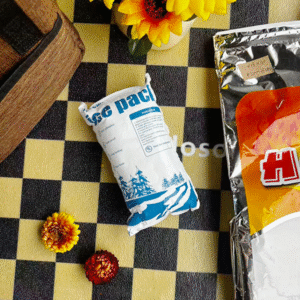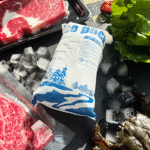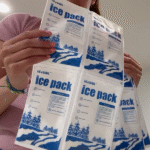Comment peut-on 48-Feuilles de glace carbonique d'une heure Transformez vos résultats d'expédition congelés?
L’expédition de produits surgelés pendant deux jours nécessite un contrôle précis de la température que les blocs de glace standards ne peuvent pas fournir.. 48-Des feuilles de glace carbonique d'une heure offrent un refroidissement fiable à -78,5°C pour un transport prolongé, vous assurer que vos denrées périssables arrivent congelées et fraîches. Le marché mondial de la chaîne du froid devrait atteindre $500 milliards 2025, rendant le contrôle efficace de la température plus critique que jamais pour le succès des expéditions.

– De quelle quantité de glace carbonique avez-vous besoin pour différentes tailles d'envoi?
– Quelle configuration d'emballage permet de conserver les produits congelés pendant exactement 48 heures?
– Quelles règles de sécurité et exigences d'étiquetage devez-vous respecter?
– Comment valider et surveiller vos performances d’expédition de glace carbonique?
– Quoi 2025 les tendances de la chaîne du froid auront un impact sur votre stratégie d'expédition?
## De quelle quantité de glace carbonique pour 48 heures avez-vous réellement besoin?
**Commencez par un simple 1:1 rapport entre le poids de la glace carbonique et le poids du produit pour des performances fiables sur 48 heures.** Cette référence suppose une isolation adéquate et des conditions d'expédition standard.. Par exemple, expédition 8 livres de fruits de mer surgelés commenceraient par 8 livres de glace carbonique. Le 1:1 la règle fonctionne parce que la neige carbonique sublime (passe directement du solide au gaz) à un rythme prévisible, absorber la chaleur de vos produits tout en maintenant des températures inférieures à zéro constantes.
Vos besoins réels en glace carbonique dépendent de trois facteurs clés: températures saisonnières, complexité des itinéraires de navigation, et qualité de l'isolation. Les expéditions estivales nécessitent généralement 25-35% plus de neige carbonique que les expéditions hivernales en raison des températures ambiantes plus élevées. Itinéraires multi-transferts nécessitant des transferts fréquents de colis 10-15% glace carbonique supplémentaire par rapport aux expéditions directes. Une meilleure isolation peut réduire vos besoins en glace sèche en 10-25%, rendre l'investissement dans des matériaux d'emballage de qualité rentable au fil du temps.
### Formule de dimensionnement de glace carbonique et estimateur rapide
Utilisez ce calcul simple pour déterminer vos besoins exacts en glace carbonique: référence = poids du produit × 1.0, puis ajuster selon la saison (0.00 hiver, 0.15 printemps/automne, 0.35 été), itinéraire (0.00 standard, 0.10 transfert multiple, 0.15 voie chaude), et isolation (0.00 pour la norme, -0.10 pour prime, -0.25 pour panneaux isolés sous vide). Multipliez ces facteurs ensemble pour obtenir votre recommandation finale en matière de poids de glace carbonique.
| Poids du produit | Commencer la glace sèche | Quand en ajouter plus | Ce que cela signifie pour vous |
|—————-|——————|——————|———————-|
| 4 kg | 4-5 kg | Voie chaude en été | Tenue fiable pendant 48 heures avec une isolation standard |
| 8 kg | 8-10 kg | Itinéraires à transferts multiples | Envisagez une isolation sous vide si le poids est serré |
| 12 kg | 12-15 kg | Voies très chaudes | Surveillance de la température + isolation premium recommandée |
### Scénarios pratiques et conseils d'ajustement
– **Expédition de fruits de mer d'été:** Utiliser 35% glace carbonique supplémentaire et inclure des enregistreurs de données de température
– **Échantillons pharmaceutiques:** Ajoutez des panneaux isolés sous vide et réduisez la glace carbonique de 20%
– **Livraisons multi-arrêts:** Augmentez la glace carbonique de 15% et utiliser des présentations d'emballage hybrides
> **Cas réel:** Une expédition de boulangerie 6 livres de pâtisseries surgelées en été, isolation améliorée de 1 pouce à 1,75 pouce et augmentation de la glace carbonique de 6 à 8 livres. Leur température centrale est restée inférieure à -10°C pendant 52 heures malgré des conditions de transit chaudes.
## Quelle configuration d'emballage offre des performances de congélation fiables pendant 48 heures?
**Construisez un système d'isolation ventilé avec des feuilles de glace carbonique placées sur le dessus et un contrôle approprié des vides pour une efficacité maximale.** Cette configuration exploite la propriété naturelle de descente de l'air froid tout en empêchant l'accumulation dangereuse de CO₂.. Votre emballage doit inclure un conteneur isotherme (Panneaux en mousse EPS ou sous vide), les produits surgelés correctement ensachés et centrés, des feuilles de glace carbonique placées sur le dessus, et une ventilation adéquate pour l'évacuation des gaz.
Les packouts les plus efficaces combinent plusieurs éléments: isolation de qualité, placement stratégique de glace carbonique, et une gestion minutieuse des vides. Le meilleur placement fournit 24-36 heures de refroidissement fiable, tandis que les mises en page hybrides (glace sur le dessus et les côtés) peut étendre les performances à 48-72 heures. Préconditionnez toujours vos produits en les congelant en dessous de -18°C et refroidissez les composants de l'emballage avant l'assemblage afin de réduire la charge thermique initiale sur votre glace carbonique..
### Techniques d'emballage avancées pour une durée prolongée
– **Emballages hybrides:** Combinez de la neige carbonique avec des matériaux à changement de phase pour un tampon de température
– **Contrôle du vide:** Utilisez des tampons en mousse ou du papier froissé pour éliminer les espaces d'air qui provoquent des fluctuations de température
– **Approche en couches:** Placez des feuilles de glace carbonique plus fines plutôt que des blocs simples et épais pour une sublimation plus uniforme.
| Type de mise en page | Taux de sublimation | Durée | Mieux pour |
|————-|——————|———-|———-|
| Meilleur emplacement | 8-12% par 24 heures | 24-36 heures | Expéditions standards |
| Disposition Surround | 6-9% par 24 heures | 36-60 heures | Produits sensibles |
| Disposition hybride | 5-8% par 24 heures | 48-72 heures | 48-missions d'une heure |
### Liste de contrôle essentielle de sécurité et de conformité
– **Toujours ventiler les conteneurs:** Ne scellez jamais de glace carbonique dans des emballages hermétiques pour éviter l’accumulation de pression.
– **Utiliser un équipement de protection:** Portez des gants et des lunettes isolants lors de la manipulation de glace carbonique
– **Respecter les exigences d'étiquetage:** Appliquer les marquages et la classe UN1845 9 étiquettes de danger
– **Fournir des instructions de manipulation:** Inclure des notes de soins du destinataire pour un déballage en toute sécurité
## Quelles réglementations de sécurité régissent les expéditions de glace sèche en 48 heures?
**La neige carbonique est classée comme marchandise dangereuse UN1845 nécessitant un étiquetage spécifique, documentation sur le poids, et précautions de sécurité.** Pour les expéditions aériennes, vous devez marquer les colis avec “UN1845, Glace carbonique ou dioxyde de carbone, solide” et afficher le poids net de glace carbonique en kilogrammes. Une classe carrée de 100 mm 9 l'étiquette de danger est obligatoire, avec une hauteur de caractère d'au moins 12 mm lorsque la capacité du colis dépasse 30 kg.
Différents transporteurs ont des exigences différentes pour les expéditions de glace carbonique. FedEx Express n'exige pas de déclaration de l'expéditeur lorsque la neige carbonique est la seule marchandise dangereuse, mais des marquages appropriés sont essentiels. UPS suit des règles similaires, tandis que les États-Unis. Le service postal autorise les colis de glace carbonique nationaux conformément à l'instruction d'emballage 9A.. Les compagnies aériennes limitent généralement la glace carbonique dans les bagages des passagers à 2,5 kg (5.5 livres), vérifiez donc toujours les politiques spécifiques du transporteur avant l'expédition.
### Protocoles de sécurité critiques pour la manipulation de la glace carbonique
– **Directives de stockage:** Conservez la glace carbonique dans des endroits bien ventilés et jamais dans des contenants hermétiques
– **Méthodes d'élimination:** Laissez la neige carbonique inutilisée se sublimer à l'extérieur en toute sécurité, des espaces bien ventilés
– **Procédures d'urgence:** Former le personnel sur le traitement des engelures et la réponse à l'exposition au CO₂
– **Communication client:** Inclure des instructions de traitement claires pour les destinataires finaux
## Comment valider et surveiller les performances d’expédition de glace carbonique?
**Mettre en œuvre un plan de validation en trois étapes combinant des tests sur banc, pilotes de voie, et des procédures standardisées pour garantir des performances de 48 heures.** Commencez par ISTA 7E ou Standard 20 profils de test qui simulent les conditions estivales et hivernales pour établir des performances de base. Documentez les courbes de température au niveau du cœur et près de la paroi pour identifier les points faibles potentiels de votre système d'emballage..
La validation en situation réelle via des pilotes de voie fournit les données de performances les plus fiables. Effectuez des expéditions à petite échelle via vos itinéraires d'expédition actuels avec 25-50% glace carbonique supplémentaire comme tampon de sécurité. Examinez les résultats de l'enregistreur de données pour identifier les écarts de température et ajustez votre emballage en conséquence.. Cette approche détecte des variables du monde réel telles que les retards de manipulation et les fluctuations de température que les tests en laboratoire pourraient manquer..
### Options technologiques de surveillance pour différents besoins
– **Validation de base:** Enregistreurs de données USB pour un enregistrement économique de la température
– **Suivi en temps réel:** Capteurs IoT comme FedEx SenseAware pour la surveillance et l'intervention en direct
– **Documents de conformité:** Enregistreurs compatibles NFC pour une récupération et un reporting faciles des données
– **Surveillance de la sécurité:** Détecteurs de CO₂ dans les zones de transit pour éviter l'accumulation de gaz
## 2025 Développements et tendances en matière de logistique de la chaîne du froid
Le marché de la chaîne du froid connaît une transformation rapide motivée par l’adoption de technologies, pressions en matière de durabilité, et réglementations évolutives. Grand View Research prévoit que le marché mondial de la chaîne du froid atteindra $1,611 milliards 2033, grandir à 20.1% CAGR de 2025. Cette expansion est alimentée par la demande croissante d’aliments frais et surgelés du commerce électronique., ainsi que des besoins accrus en matière d’expédition de produits pharmaceutiques.
### Dernières innovations façonnant le transport de glace carbonique
– **Surveillance intelligente de la température:** Capteurs IoT fournissant des alertes en temps réel sur les écarts de température
– **Emballage durable:** Expéditeurs thermiques recyclables maintenant les températures pendant 72+ heures
– **Transparence de la blockchain:** Technologie de grand livre distribué garantissant l’intégrité de la chaîne d’approvisionnement
– **Réfrigération hybride:** Unités de transport électriques et hybrides réduisant l’impact environnemental
– **Intégration de l'automatisation:** La robotique et l'IA optimisent les opérations de l'entrepôt et réduisent les erreurs
Un aperçu du marché révèle que l'Amérique du Nord a résisté 33% de la part des revenus de la chaîne du froid dans 2024, avec le segment congelé (-18°C à -25°C) dominant le marché. Entre-temps, Global Market Insights note que le marché des équipements logistiques pour la chaîne du froid passera de $94.3 milliards en 2025 à $179.8 milliards 2034, tirée par la demande de produits pharmaceutiques et de denrées périssables.
## Questions fréquemment posées
**De combien de livres de glace carbonique ai-je besoin pour 10 lb de viande congelée pour 48 heures?**
Commencez par environ 10 livres de glace carbonique en utilisant le 1:1 rapport, puis ajouter 25-35% pour les expéditions estivales ou les voies chaudes. Validez toujours avec des enregistreurs de température pour confirmer les performances dans vos conditions d'expédition spécifiques..
**Quel étiquetage est requis pour les expéditions de glace sèche?**
Marquer les colis avec “UN1845, Glace carbonique ou dioxyde de carbone, solide,” afficher le poids net en kilogrammes, et appliquez une classe de 100 mm × 100 mm 9 étiquette de danger. La hauteur des caractères doit être d'au moins 12 mm lorsque la capacité du colis dépasse 30 kg..
**Puis-je expédier des colis de glace carbonique via USPS?**
Oui, au niveau national. Les colis doivent évacuer le CO₂ et répondre aux exigences de l’instruction d’emballage 9A.. Vérifiez toujours les dernières réglementations USPS avant l'expédition car les politiques peuvent changer.
**Quelles sont les restrictions des compagnies aériennes concernant la glace carbonique dans les bagages?**
Les compagnies aériennes plafonnent généralement la glace carbonique à 2,5 kg (5.5kg) dans les bagages des passagers. Vérifiez toujours la politique spécifique de votre transporteur et assurez-vous qu'une ventilation adéquate est assurée pendant le transport..
**Combien de temps dure généralement la glace carbonique en vrac?**
Les packs de glace carbonique en vrac durent généralement 24-72 heures en fonction de la qualité de l'isolation et de la disposition de l'emballage. Les panneaux isolés sous vide peuvent prolonger cette durée, alors qu'une mauvaise isolation peut le réduire considérablement.
## Résumé et recommandations
48-Des feuilles de glace carbonique d'une heure assurent une expédition fiable des produits congelés lorsqu'elles sont correctement dimensionnées, emballé, et surveillé. N'oubliez pas ces points clés à retenir: commencer par le 1:1 rapport poids de glace carbonique/produit et ajustement aux conditions; construire des packouts ventilés avec une isolation appropriée et un placement supérieur; être conforme à l'étiquetage UN1845 et à la documentation sur le poids; valider les performances avec des tests réels; et restez informé de 2025 tendances de la chaîne du froid affectant la disponibilité et la réglementation de la neige carbonique.
Mettez en œuvre ces étapes concrètes pour optimiser vos expéditions congelées: calculez vos besoins en glace carbonique à l'aide de l'estimateur fourni; mise à niveau vers une isolation plus épaisse pour des temps de maintien plus longs; standardisez les procédures d’emballage avec des SOP claires; surveiller les expéditions avec des enregistreurs de données; et explorez des options durables comme les doublures VIP réutilisables. Ces mesures vous aideront à livrer des produits surgelés en toute confiance tout en réduisant la détérioration et les problèmes de conformité..
## À propos du tempk
Et tempk, nous sommes spécialisés dans les solutions d'emballage à température contrôlée, notamment les feuilles de glace carbonique de 48 heures, expéditeurs isolés, et systèmes VIP réutilisables. Notre laboratoire certifié CNAS développe des emballages validés par voie qui réduisent la consommation de glace carbonique tout en maintenant la fiabilité.. Nous investissons continuellement dans des matériaux et des technologies durables pour aider nos clients à minimiser l'impact environnemental tout en répondant à des exigences strictes en matière de température..
**Contactez nos experts en chaîne du froid dès aujourd'hui pour une évaluation personnalisée de l'expédition et une consultation sur le dimensionnement de la glace carbonique adaptée à vos produits et itinéraires spécifiques.**























